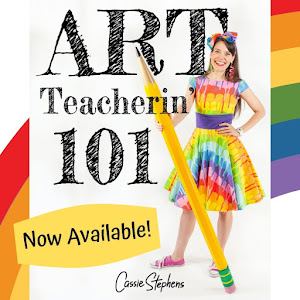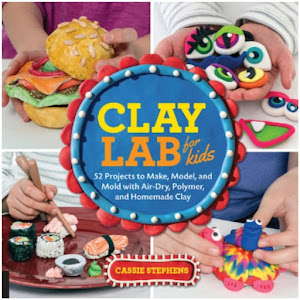So, what am I trying to say? Who knows...that's the point, I certainly don't know! What I do know is that I hope you'll take a listen to Everyday Art Room if you haven't already. I have LOVED working on this podcast...I hope you enjoy it just as much. In case you are interested, here is the transcript:
Some of you guys might know that I have a gong in my art room. That’s gong with a G, thank you very much. It’s our cleanup gong. It is a massive gong, 24-inch, and it is probably the coolest thing in my room, according to my students. I’ve been asked, “How did you get a gong in your art room?”
Well, it was a 10-year wedding anniversary gift, my present. What? You guys didn’t get one of those? Yeah, I’m pretty sure that’s not the standard 10-year wedding anniversary gift, but it is if you are in my household. Anyway, I digress. It is obviously the coolest thing in my room, and we use it as a signal for cleanup.
As you know, cleanup can be a little bit hairy, so imagine, if you will, this scenario. I’ve got a room full of 25 first graders. We’re late, as usual. We’ve been painting, and cleanup has become pandemonium. I have a student. She’s standing at the gong. Her one and only job is to hit the gong, to signal to everybody else to stop and clean up, but for some reason, she’s frozen. She’s holding the mallet. She’s standing at the gong, and she’s not hitting the gong. It’s just then, that the classroom teacher walks in, and my administrator, to see, number one, why am I running late, as usual, and two, what’s all the chaos about?
That’s when, from across the room, a little girl shouts, “Hit the bong! It’s time to hit the bong!” to the frozen little girl at the gong with a G. It’s then, my admin turns to me and says, “Really, Stephens? Really?” This is Everyday Art Room, and I’m Cassie Stephens.
Today, we’re going to talk about all things cleanup. Cleanup, as you know, is a really important part of your art class, for a couple of reasons. It can salvage your sanity, your art supplies, and it’s how you end your art class. You always want to end your art class on a positive and upbeat note, not one where kids are yelling about hitting a bong and not cleaning your room up to your expectations.
Today, I’m going to share with you the Four F’s of Cleanup: How to Make Sure that Your Cleanup is Fun, Fast, Chaos Free, and has a Flow. I’m going to share those four tips with you today and hope that it’s something that you can take back to your art room and ensure that your cleanup is fun, fast, chaos free–there’s my F; that’s why I keep emphasizing free–and has a flow. Let’s start at the beginning.
Before you can think about how you’re going to introduce cleanup to your students, you need to put yourself in your students’ shoes. Go sit at one of their tables, get a paper, get some paint, have a little fun and create a painting, just relax. As you’re sitting there working, think about how the art room looks, through your students’ eyes. Then think about cleanup. Where will your students put their dirty brushes? Where will your students put their painting? Do you have one drying rack or multiple ones, like I do? Where will you position that drying rack, so that it’s easy for your students to get to, so there’s not a bottleneck of children? How will they clean their hands–oh, my goodness!–the bane of our existence? Once you’ve really sat down and thought those things through, then you’ll be much better prepared to introduce a cleanup routine that’s fun, fast–say it with me–chaos free, and has a flow. Let me share with you how my cleanup looks.
First of all, before my students even gather up their supplies to start their project, I do call and response. Call and response, if you’re not familiar, is when your students repeat after you. Believe it or not, I do this for every class, kindergarten through fourth grade, done it for years, so the kids know what to expect. In order for me to get their attention, to remind them that they’re about to repeat after me, I simply clear my throat–ahem–and they know that whatever I’m about to say, they are going to repeat.
I usually go through what our directions are for the day, what supplies they will be using, and I also cover cleanup. It might sound a little like this: “When I’m finished,” and then I pause for them to repeat, “I will take my paintbrush to the paintbrush hot tub.” That’s right. We have a can full of water that we refer to as the paintbrush hot tub. I have found that the sillier you make things, the more they stick. Silly sticks, so give that paintbrush hot tub a fancy name, and they’ll remember it.
Call and response really works for me in my art room, because it gets all of the children repeating with me and doing hand jives and hand motions where they will be cleaning up. That’s one way to make your cleanup a little faster. If your students know in advance what they are to do when they finish–and this really helps those early finishers–they don’t have to come up to you and ask you, “Hey, where do I put my painting?” because they already know. If you can get a call and response going, or if you can instill in your students where everything goes, before they even start working, that will make your cleanup a lot faster.
Now, let’s talk about chaos free. Whew! Last year, I had doubled up third and fourth grade classes. That means I was maxing out around 35 kids in my room, big kids, not the littles, and it could get really chaotic during cleanup. I mean, I literally would jut stand back and watch the chaos. I thought to myself, “Oh, it’s fine. It’s because there’s 35 of them. It’s supposed to look like this.” No, y’all. It doesn’t have to look that way. Let’s talk about how to make your cleanup chaos free.
I have a time timer in my room, and I set it so that it goes off about seven minutes before we are to leave, and that’s our two-minute warning. About two minutes before cleanup, in an effort to try to make cleanup chaos free, when the timer goes off, all of my students are to go to level zero–that means they are silent–and I just cover where everything goes, one more time, with them, and I make them help me with this. I’ll say, “Please point to where dirty paintbrushes go,” and all arms swing toward the paintbrush hot tub. “Please point to which drying rack you will be using. Please point to where aprons go. Please point to where baby wipes can be found,” if we’re using them that day. That way, one more time, in just a matter of seconds, all of my students understand where everything is going to go, so there’s no confusion and hopefully a little less chaos during cleanup.
Now, let’s talk about flow. Remember when I mentioned that you should sit and create a painting? When you’re done with that painting, make sure, when you’re putting things away, that there’s a flow, a flow of traffic. Think about yourself being like a crossing guard or a person directing traffic. You want the traffic of your room to have a flow, to make sense. Last year, I had all of my drying racks–they’re small and moveable–all in one place, and it created a huge bottleneck of children getting to the drying rack. Somebody always ended up dropping a painting or getting paint on them.
This year, I moved my drying racks in such a way that they are at the ends of every long table where children sit, so when they stand up, they’re automatically in line to put their artwork on the correct drying rack. It only took me 19 years to figure that one out, so I’m sharing it with you. I hope that little nugget helps you out. Think about how you could have more of a flow, so it’s not children going every which way. I even recently picked up, from the Dollar Tree, some of these reusable arrows that stick to the floor. That’s been a great way for me to visually share with my students my flow of traffic.
Now, last but not least is how to make cleanup fun. Okay, brace yourselves. I’m going to tell you about the best thing ever! It is called the cleanup contest. Dum-dum-dah! Oh, my goodness! This is a hit. Let me tell you how this goes down. I always pick one student, who’s working extremely hard, to play the cleanup gong. The gong is played five minutes prior to cleanup. When the kids hear the cleanup gong, this is how the contest works. They are to clean up at level zero. That’s right, silent cleanup. The reason we do this is because it really cuts down on the chaos.
I noticed a lot of times when we were cleaning, there were a lot of conversations going on that didn’t entail creating art and definitely didn’t have anything to do with cleanup, so forget about it. Go to silent cleanup. As the students are cleaning up, they are responsible for their own area.
I have yet to master the table jobs, so all of my students are responsible for cleaning after themselves. However, if they are finished cleaning up, and they have friends at their table who need help, they are to step up and help them out, so all of the tables are working together. They’re a team to get their tables tidy. The way the kids show me that they are completely finished cleaning up is they are to stand behind their pushed in chair, with a zero in the air, meaning they have their hand up, and they’re creating a zero with their fingers. This is how their table shows me they are ready. Usually, I try to emphasize that the best table gets all sorts of privileges. We don’t know what they are, but they just get a lot of praise from me. Isn’t that a privilege in itself?
Then I will usually choose one student, who’s standing exceptionally well, to be the cleanup contest judge. I’ll call that child to stand right next to me, and I have all of the kids–this is where the fun part comes in–do a drum roll on the back of their chair. It’s like a thunder in my room, a roar of thunder, and the kids stop when the judge makes the stop motion with their arm. One way to really ensure that they stop is to tell them that the judge is basing their choice upon who stops the fastest.
When the judge makes that motion with their arm, I make a big announcement, like this, “And the winner of the cleanup contest is …” I pass it over to the judge. They announce the table, and then there’s an eruption of an applause, and that table gets to line up, at level zero. Ah, and that’s how we do cleanup. It’s fun. It’s fast. It’s chaos free, as much as cleanup in the art room can be, and there’s a flow.
I hope that those tips have helped you. I hope that you can add them to your already awesome cleanup routine to make it even more awesomer. Thanks for letting me share that with you guys. It was fun.
Now it’s time to take a little dip into the mailbag. This question comes from Robin. Robin asks, “Do you have any wise words of advice to share about student teaching or teaching in general?”
Whew! That’s a big one, Robin. I think I can help you out in a couple of short tips, but that actually sounds like an episode of Everyday Art Room, if I’m going to be honest, but let me see if I can help you out. I just jotted down a couple of my tips, words of advice that I would give somebody, who’s venturing into their first year of teaching or student teaching. Boy, that question brought back a lot of memories.
First of all, biggest and most important, is please be on time or, better yet, be early. I remember when I was student teaching, I always made sure to get there before my cooperating teacher. I was overwhelmed, anxious, had a lot of things that I felt like I needed to do, and just getting there early and actually having a little bit of time to myself was wonderful. I have had cooperating teachers in my room, not my student teachers but visitors to my art room, who’ve been late before, who’ve been no-call no-shows, and I can tell you, before I even met that person, I had already formed an opinion of them. Leave your house early. Give yourself plenty of time. Make sure everything’s ready to go, so you’re not feeling scattered and rushed and flustered, and quite possibly could get into a car accident on your way. That is my biggest, number one tip: Be on time.
Of course, another tip I would offer is to get out and meet the other teachers. Believe it or not, I’m actually kind of shy. I don’t enjoy meeting people that I don’t know. It kind of freaks me out. It’s something that I work on all the time. My advice would be that you need to do that, though. You need to get out of your art room and meet other people. Introduce yourself, share ideas, collaborate. That being said, don’t be a doormat, meaning don’t open up your art room to art supply giveaway. Remember, you are not a craft store, and teachers need to know that, as well, and you don’t want to be taken advantage of. Next thing you know, you’re making posters for everybody on the planet. You need to make sure that, despite getting out and making new friends, you aren’t taken advantage of, and neither is your art room.
That was a great question, Robin, and, like I said, one that I think I need to explore more in an upcoming podcast. Do you have a question for the mailbag? Please feel free to email me at everydayartroom@theartofed.com. I would love to hear from you.
It’s been a blast sharing with you guys cleanup. Who knew cleanup could be a blast, but why not make it that way? Remember, by a blast, I don’t mean that it needs to be chaotic. Let’s talk about it. Remember, you can make your cleanup fast by doing a call and response at the beginning of class. That way all of the kids understand all of your expectations for cleanup.
You can also make it chaos free. Two minutes before cleanup, have your students point out where they’re going to place everything. That way, when it’s time for cleanup, nobody’s asking questions. Everybody knows what to do.
Also, think about your traffic flow. You want to make sure that your cleanup makes sense, so all of your kids are moving in a rhythm and not scattered all over the place, walking from one end of your room to the other. Think about your flow.
Then, last but not least, make it fun. Why not? Give my cleanup contest game a try. I would love to hear from you if you do. Remember, it’s easy, but to win, they have to clean up at level zero. Everybody is responsible for their own area, and, when they’re finished, they help buddies tidy their table, standing behind their pushed in chair with a zero in the air, and then pick a person to decide who the winners of the cleanup contest are. Of course, tie in what already works for you. Don’t throw that out the window. You guys, have an awesome time teaching art. This is Cassie Stephens, and this is Everyday Art Room.























No comments:
Post a Comment
Thank you so much for your comments. I appreciate each and every one :)
Note: Only a member of this blog may post a comment.